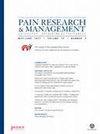慢性腰痛患者与无症状人群焦虑、睡眠质量、压力-疼痛阈值的差异及相关性
IF 2.5
3区 医学
Q2 CLINICAL NEUROLOGY
引用次数: 2
摘要
背景慢性腰痛(CLBP)是一种临床上常见且昂贵的疾病。患者经常因疼痛和功能障碍而请病假,不愉快的生活和工作经历导致心理抑郁和焦虑,影响生活质量。睡眠障碍是腰痛(LBP)患者的常见问题,超过50%的患者抱怨睡眠质量差。本研究旨在探讨焦虑、睡眠质量和压力-疼痛阈值(PPT)在CLBP患者和无症状患者之间的相关性及其差异。方法选取40例CLBP患者和40例无症状者。状态-特质焦虑量表、匹兹堡睡眠质量指数、PPT等相关数据由持有执业证书的盲法物理治疗师单独独立采集,并进行统计分析。使用独立样本t检验来确定CLBP患者和无症状人群之间的组间差异。采用Pearson相关系数进行相关分析。结果CLBP组焦虑评分明显高于对照组(41.64±9.88∶36.69±8.31;T =−2.496,p=0.015)高于无症状组。两组匹兹堡睡眠质量指数总分(6.41±2.43∶5.09±2.18;T =−2.628,p=0.010),但在特质焦虑方面无显著差异(44.00±7.83∶42.67±9.51;T =−0.695,p=0.489)。状态-特质焦虑量表与PPT呈低至中度负相关。匹兹堡睡眠质量指数与PPT无显著相关。结论CLBP患者的状态焦虑和睡眠质量明显差于无症状者;然而,两组之间PPT没有明显差异。结果提示,在临床实践中,应关注疼痛及其相关的社会心理因素。CLBP的治疗可以从多个角度和学科进行考虑。本试验已在中国临床试验注册中心注册(试验注册号:ChiCTR-TRC-13003701)。本文章由计算机程序翻译,如有差异,请以英文原文为准。
Differences and Correlations of Anxiety, Sleep Quality, and Pressure-Pain Threshold between Patients with Chronic Low Back Pain and Asymptomatic People
Background Chronic low back pain (CLBP) is a clinically common and expensive disease. Patients frequently take sick leaves because of pain and dysfunction, and their unpleasant life and work experiences cause psychological depression and anxiety and affect their quality of life. Sleep disturbance is a common problem among patients with low back pain (LBP) with more than 50% complaining about poor sleep quality. This study aimed to explore the correlations between anxiety, sleep quality, and pressure-pain threshold (PPT) and their differences between patients with CLBP and asymptomatic people. Methods Forty patients with CLBP and 40 asymptomatic people were recruited. Relevant data, including State-Trait Anxiety Inventory, Pittsburgh Sleep Quality Index, and PPT, were individually and independently collected by blinded physiotherapists with a practicing certificate and then statistically analyzed. An independent sample t-test was used to determine the intergroup differences between patients with CLBP and asymptomatic populations. Pearson correlation coefficient was employed for correlation analysis. Results The CLBP group had significantly higher anxiety scores (41.64 ± 9.88 vs. 36.69 ± 8.31; t = −2.496, p=0.015) than the asymptomatic group. A significant difference was found in the total score of the Pittsburgh Sleep Quality Index (6.41 ± 2.43 vs. 5.09 ± 2.18; t = −2.628, p=0.010) but not in the trait anxiety (44.00 ± 7.83 vs. 42.67 ± 9.51; t = −0.695, p=0.489) of the two groups. State−Trait Anxiety Inventory showed a low to moderate negative correlation with PPT. No remarkable correlation was observed between Pittsburgh Sleep Quality Index and PPT. Conclusions Patients with CLBP showed considerably worse state anxiety and sleep quality than asymptomatic people; however, no substantial difference in PPT was found between the two groups. The results suggest that in clinical practice, the focus should include pain and related social and psychological factors. CLBP treatment could be considered from multiple perspectives and disciplines.This trial is registered with Chinese Clinical Trial Registry (Trial registration: ChiCTR-TRC-13003701).
求助全文
通过发布文献求助,成功后即可免费获取论文全文。
去求助
来源期刊

Pain Research & Management
CLINICAL NEUROLOGY-
CiteScore
5.30
自引率
0.00%
发文量
109
审稿时长
>12 weeks
期刊介绍:
Pain Research and Management is a peer-reviewed, Open Access journal that publishes original research articles, review articles, and clinical studies in all areas of pain management.
The most recent Impact Factor for Pain Research and Management is 1.685 according to the 2015 Journal Citation Reports released by Thomson Reuters in 2016.
 求助内容:
求助内容: 应助结果提醒方式:
应助结果提醒方式:


